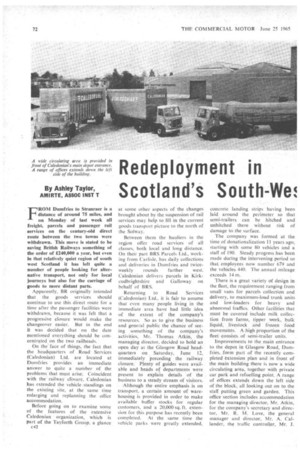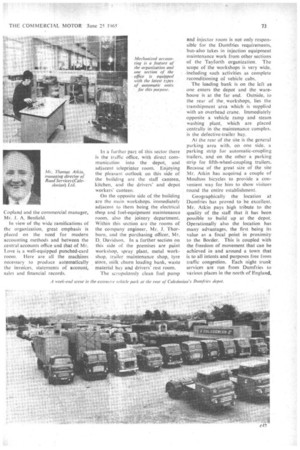Redeployment in Scotland's South-We!
Page 74

Page 75

Page 76

If you've noticed an error in this article please click here to report it so we can fix it.
By Ashley Taylor, AMIRTE, ASSOC INST T
FROM Dumfries to Stranraer is a distance of around 75 miles, and on Monday of last week all freight, parcels and passenger rail services on the century-old direct route between the two towns were withdrawn. This move is stated to be saving British Railways something of the order of 1240,000 a year, but even in that relatively quiet region of south west Scotland it has left quite a number of people looking for alternative transport, not only for local journeys but also for the carriage of goods to more distant parts.
Apparently, BR originally intended that the goods services should continue to use this direct route for a time after the passenger facilities were withdrawn,. because it was felt that a progressive closure would make the changeover easier. But in the end it was decided that on the date mentioned everything should be concentrated on the two railheads.
On the' face of things, the fact that the headquarters of Road Services (Caledonian) Ltd. are located at Dumfries provides an immediate answer to quite a number of the problems that must arise. Coincident with the railway crosure, Caledonian has extended the vehicle standings on the existing site, at the same time enlarging and replanning the office accommodation.
Before going on to examine some of the features of the extensive Caledonian organization, which is part of the Tayforth Group. a glance c42 at some other aspects of the changes brought about by the suspension of rail services may help to fill in the current goods transport picture to the north of the Solway.
Between them the hauliers in the region offer road services of all classes, both local and long distance. On their part BRS Parcels Ltd„ working from Carlisle, has daily collections and deliveries in Dumfries and twice weekly rounds farther west. Caledonian delivers parcels in Kirkcudbrightshire and Galloway on behalf of BRS.
Returning to Road Services (Caledonian) Ltd., it is fair to assume that even many people living in the immediate area have had little idea of the extent of the company's resources. So as to give the business and general public the chance of seeing something of the company's activities, Mr. Thomas Atkin, the managing director, decided to hold an open day at the Glasgow Road headquarters on Saturday, June 12, immediately preceding the railway closure. Plenty of guides were available and heads of departrrients were present to explain details of the business to a steady stream of visitors.
Although the entire emphasis is on transport, a certain amount of warehousing is provided in order to make available buffer stocks for regular customers, and a 20,000 sq. ft. extension for this purpose has recently been completed. At the same time the vehicle parks were greatly extended, concrete landing strips having been laid around the perimeter so that semi-trailers can be hitched and unhitched there without risk of damage to the surface.
The company was formed at the time of denationalization 11 years ago, starting with some 80 vehicles and a staff of 190. Steady progress has been made during the intervening period so that employees now number 679 and the vehicles 440. The annual mileage exceeds 14 m.
There is a great variety of design in the fleet, the requirement ranging from small vans for parcels collection and delivery, to maximum-load trunk units and low-loaders for heavy and abnormal traffics. Other facilities that must be covered include milk collection from farms, tipper work, bulk liquid, livestock and frozen food movements. A high proportion of the fleet consists of semi-trailer units.
Improvements to the main entrance to the depot in Glasgow Road, Dumfries, form part of the recently completed extension plan and in front of the main building there is now a wide circulating area, together with private car park and refuelling point. A range of offices extends down the left side of the block, all looking out on to the staff putting green and garden. This office section includes accommodation for the managing director, Mr. Atkin, for the company's secretary and director. Mr. R. M. Love, the general manager and director, Mr. A. Callander, the traffic controller, Mr. J. Copland and the commercial manager, Mr. J. A. Benfield.
In view of the wide ramifications of the organization, great emphasis is placed on the need for modern accounting methods and between the central accounts office and that of Mr. Love is a well-equipped punched-card room. Here are all the machines necessary to produce automatically the invoices, statements of account, sales and financial records. In a further part of this sector there is the traffic office, with direct communication into the depot, and adjacent teleprinter room. Enjoying the pleasant outlook on this side of the building are the staff canteen, kitchen, and the drivers' and depot workers' canteen.
On the opposite side of the building are the main workshops, immediately adjacent to them being the electrical shop and fuel-equipment maintenance room, also the joinery department. Within this section are the rooms of the company engineer, Mr. 1. Thorburn, and the purchasing officer, Mr. D. Davidson. In a further section on this side of the premises are paint workshop, spray plant, metal workshop, trailer maintenance shop, tyre store, milk churn loading bank, waste material bay and drivers' rest room.
The scrupulously clean fuel pump
and injector room is not only responsible for the Dumfries requirements, but-also takes in injection equipment maintenance work from other sections of the Tayforth organization. The scope of the workshops is very wide, .including such activities as complete reconditioning of vehicle cabs.
The loading bank is on the left as one enters the depot and the warehouse is at the far end. Outside, to the rear of the, workshops, lies the transhipment area which is supplied with an overhead crane. Immediately opposite a vehicle ramp and steam washing plant, which are placed centrally in the maintenance complex. is the defective-trailer bay.
At the rear of the site is the general parking area with, on one side, a parking strip for automatic-coupling trailers, and on the other a parking strip for fifth-wheel-coupling trailers. Because of the great size of the site Mr. Atkin has acquired a couple of Moulton bicycles to provide a convenient way for him to show visitors round the entire establishment.
Geographically the location at Dumfries has proved to be excellent. Mr. Atkin pays high tribute to the quality of the staff that it has been possible to build up at the depot. Operationally also the location has many advantages, the first being its value as a focal point in proximity to the Border. This is coupled with the freedom of movement that can be achieved in and around a town that is to all intents and purposes free from traffic congestion. Each night trunk services are run from Dumfries to various places in the north of England,
to the Midlands, London and elsewhere. In addition there are Constant departures throughout the day with loads for other distant destinations.
Caledonian has depots in London, Glasgow, Newcastle upon Tyne, Preston, Bristol, Birmingham, Stranraer, Abington, Lockerbie and Hexham. Through the Tayforth Group, the chairman of which is Sir William Duthie, the services of more than 1,500 vehicles and 30 depots are available. Mr. W. R. Alexander, deputy chairman of Tayforth Ltd., is chairman of the Caledonian company and of Road Services (Forth) Ltd., whilst Mr. Atkin, Caledonian managing director, is also director/general manager (transport) of Tayforth and managing director of Road Services (Forth) Ltd.
Caledonian is linked in this manner with Bell and Co. (Transport) Ltd., Edinburgh; Siddle C. Cook Ltd., Consett (Co. Durham): D. McKinnon (Transport) Ltd.. Kilmarnock; Road Services (Forth) Ltd., Falkirk; Scottish Parcel Carriers Ltd., Glasgow; A. Smith (Darvel) Ltd., Darvel; Watsons (Carriers) Ltd., Bishop Auckland; Caledonian Bulk Liquids Ltd., Immingham: Hanson Haulage (Huddersfield) Ltd., Huddersfield; Hanson Haulage (Leeds) Ltd.. Pudsey; Hanson Haulage (London) Ltd., E.C.1.; Hanson Haulage (Tyneside) Ltd., Gateshead; and John West and Sons (Liverpool) Ltd., Liverpool.
The Tayforth link further enables the Dumfries company to work through Eurofreight for the purpose of forwarding part loads, small consignments and parcels to the Continent.
Surveying the whole scene at the present time it looks remarkably as though any cavities left by British Railways' pruning efforts in south west Scotland will be quickly and painlessly filled. If this does not prove to be the case the fault can hardly be laid at the door of the Scottish road transport community.




























































































































